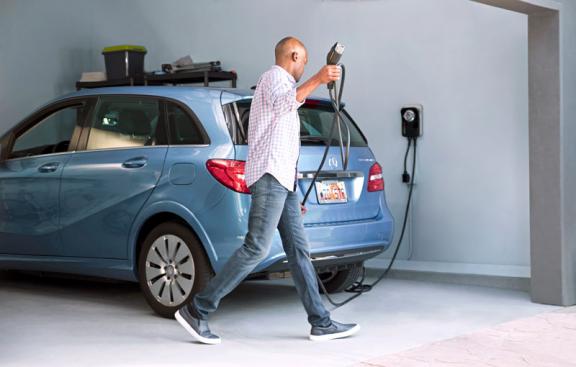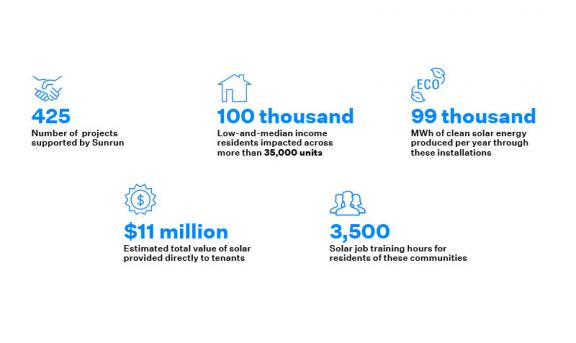The benefits of renewable energy sources are firmly established at this point, and they extend far beyond the obvious environmental value that by now is probably taken for granted. For example, they lead to more people having access to drinkable water,1 (which is no small thing considering water scarcity is predicted to become one of the largest crises in modern history2); they offer resilience to a deteriorating energy infrastructure; and, if done properly, they do less to disturb natural wildlife habitats than activities such as drilling for oil or fracking, which leads to larger ecosystems for plants and animals to thrive in. Yes, they give us clean air because they don’t produce emissions3 (and let’s not forget how big of a benefit that is) but renewable energy is not a “one trick pony.” Not by a long shot.
But to date, the benefits of clean energy haven’t been enjoyed equally by everyone. A central motivation in Sunrun’s founding in 2007 was improving on the lack of accessibility to solar power. Up to that point, the upfront cost of home solar prevented most Americans from adopting it. Co-founders Lynn Jurich and Ed Fenster pioneered the “solar as a service” model to eliminate the need for large amounts of cash on hand and hundreds of thousands of Americans have benefitted as a result. But even as rooftop solar surges forward toward mainstream adoption, the negative impacts of outdated, dirty energy sources disproportionately harm those in lower income neighborhoods.4
Research shows that lower-income communities are suffering higher exposures to pollutants than higher-income communities.5 It's worth emphasizing that the potential health consequences are far more severe than a scratchy throat and itchy eyes (namely: heart attacks, cancer, stroke, and lung disease).6 And it probably goes without saying that the medical bills that go along with pollution-induced health issues are a disproportionately bigger burden on lower-income Americans.
So, to put it succinctly: pollution is a problem for everyone but it’s an especially big problem for our most vulnerable populations.
Renewable Energy vs. Vehicle and Residential Emissions
Nearly 30% of emissions in the U.S. come from vehicles7 and the majority of Americans living below the poverty line reside in or near urban centers with heavy traffic.8 As we transition to Electric Vehicles (EVs), we should see those emissions reduced drastically but EV adoption is taking time. One of the factors preventing a quicker widespread adoption of EVs is convenient access to EV chargers. This is precisely where renewable energy—and rooftop solar especially—can play a big role.

Let the sun charge your EV
While an EV might not produce emissions, the source that provided that EV with its power in the first place very well could have. Most utility grids are flowing with power generated from a mix of sources and fossil fuels are still accounting for a huge portion of that mix.9 Plus, if the power that charged your EV was generated hundreds of miles away, there will inevitably be huge inefficiencies in transporting the electricity, even if it does come from a renewable source.
With home solar systems, both of these problems can be mitigated. The EV is able to be charged right at home, from clean energy generated in the exact same spot. And rooftop solar generates no emissions, as well cutting down on the amount of power needed from the grid, which is likely produced (at least in part) from non-renewable sources.
On that note, 25% of emissions in the U.S. come from energy production. There’s obviously a much more direct correlation here. That is, the more people who rely on solar panels, the less harmful air pollution power plants and refineries will spew out into the atmosphere, disproportionately affecting those in lower income communities.
While this gives us a ray of hope, in the face of concrete data showing the pollutants ailing many of these communities, it can seem like an idyllic fantasy. Fortunately, though, it’s not.
Using Solar To Help Low Income Communities
Sunrun’s mission from the beginning has been to create a planet run by the sun. And a big part of that belief stems from our conviction in transforming our energy system so everyone under the sun can benefit. The recent retirement of the Oakland Power Plant provided an opportunity to further that mission in a serious way.
The power previously generated by burning jet fuel couldn’t just disappear, residents still needed a source of electricity. So Surun partnered with East Bay Community Energy in Oakland, California, to ensure the new power source for many in the less affluent areas of West Oakland (and Alameda County at large) wouldn’t be the same source poisoning their air.
This small example offers a ray of hope to communities used to going without it. It provides a path forward, showing how localized clean energy can replace the emissions harming the very communities they’re supposed to serve. In turn, these residents are being further empowered by having reliable energy at predictable, affordable rates.
Clean Energy Generates Economic, And Societal, Benefits
Another of the benefits of renewable energy is it prevents rate hikes from utility companies, providing a more predictable, and potentially affordable bill. As the cost of solar continues to fall, this will become an increasingly common occurrence.
It’s not hard to connect the dots between reliable, affordable, energy and the benefit it could bring low-income communities—those who are already struggling financially are the least able to handle rate hikes (particularly surprise rate hikes). Sunrun is already working to help people’s pocketbooks, bringing solar energy to low income families throughout the state of California.
And we’re glad to say that Sunrun isn’t alone on this front. A network of people and companies who see the power of providing a better means of power to these communities. Companies like BlocPower in Brooklyn, New York, help businesses and housing units in low income neighborhoods upgrade heating and cooling systems. At this point you can probably guess the result: cheaper, cleaner, and more reliable energy for the tenets and businesses who need it most.11

This is what the future of energy can provide.
Localized networks, rather than large grids, which have the potential to provide energy when it’s needed most. It’s why we’ve provided free home batteries to vulnerable people; it’s why we welcome others to help us in the effort to extend the benefits of clean energy to everyone.
1. “Water and Energy Sustainability.” United Nations.
2. “Why is America running out of water?” National Geographic.
3. “Solar energy and the environment.” U.S. Energy Information Administration.
4. “Fine-particle air pollution has decreased across the US, but poor and minority communities are still the most polluted.” Rice University.
5. “Fine Particulate Air Pollution from Electricity Generation in the US: Health Impacts by Race, Income, and Geography" University of Washington.
6. “Breathe Life: How air pollution impacts your body.” World Health Organization.
7. “Sources of Greenhouse Gas Emissions.” Environmental Protection Agency.
8. “The changing geography of US poverty.” The Brookings Institute.
9. “Electricity explained: Electricity in the United States.” U.S. Energy Information Association.
10. “The price of solar electricity has dropped 89% in 10 years.” Fast Company.
11. “Increase your building's profitability with a modern heating and cooling system.” BlocPower.
